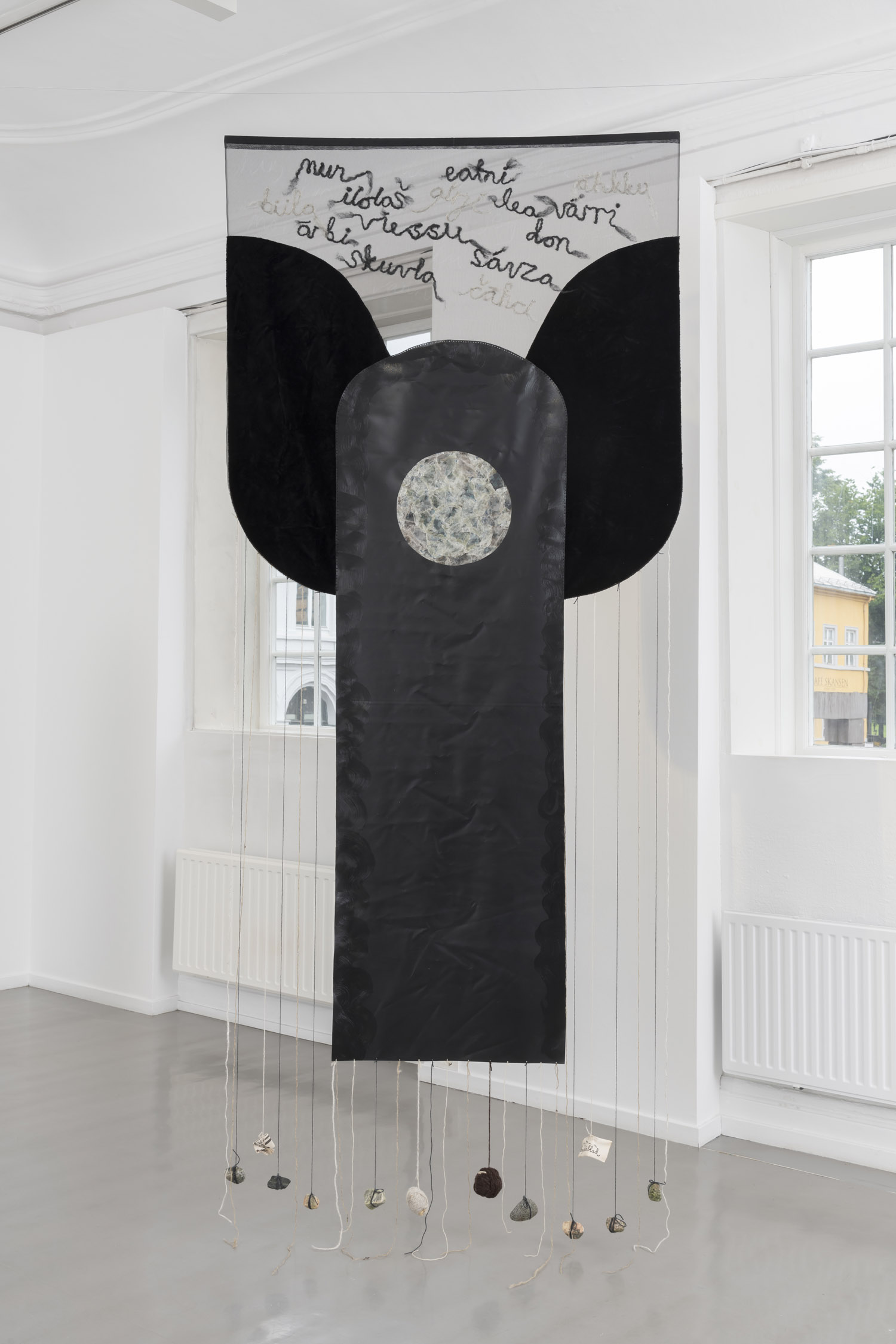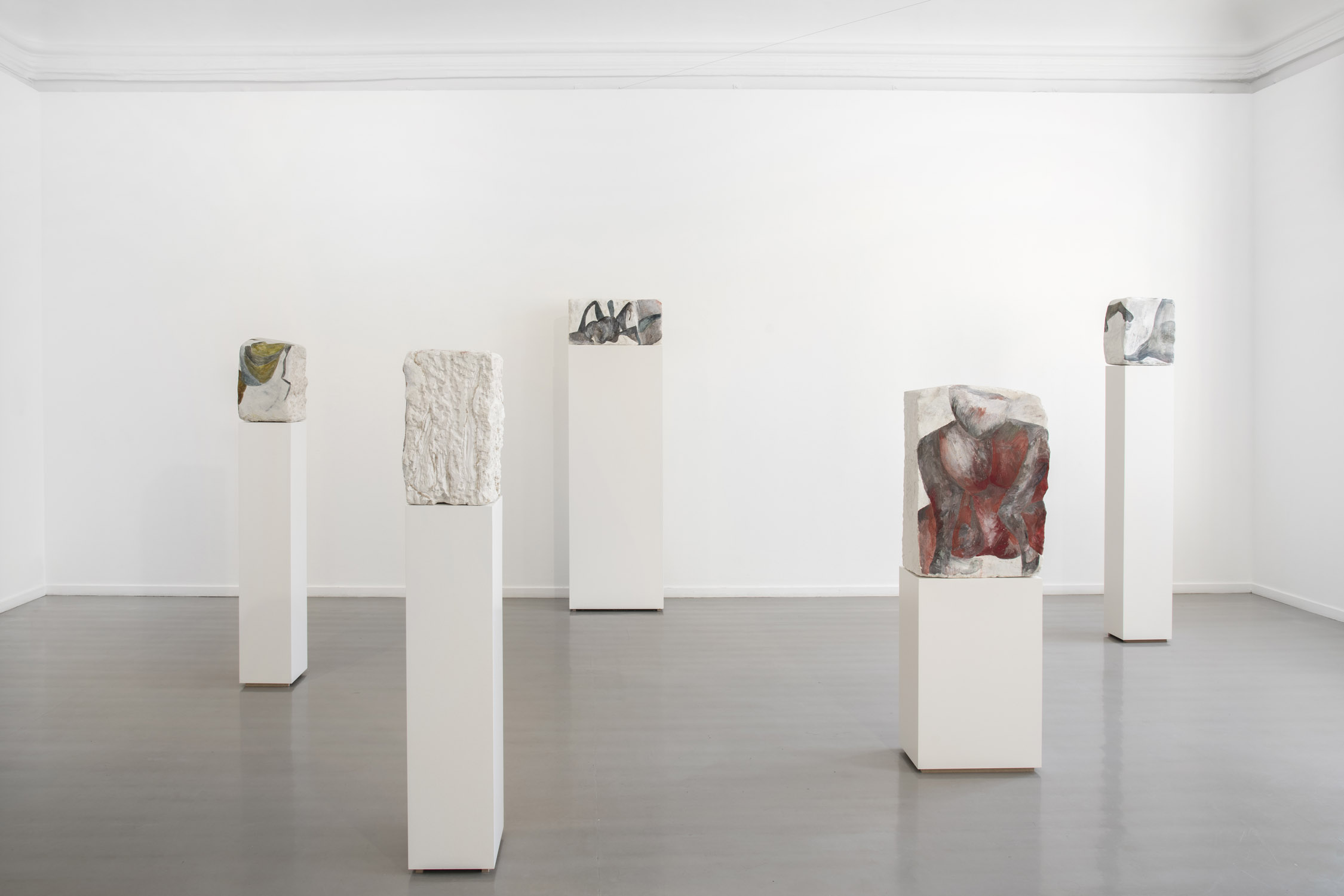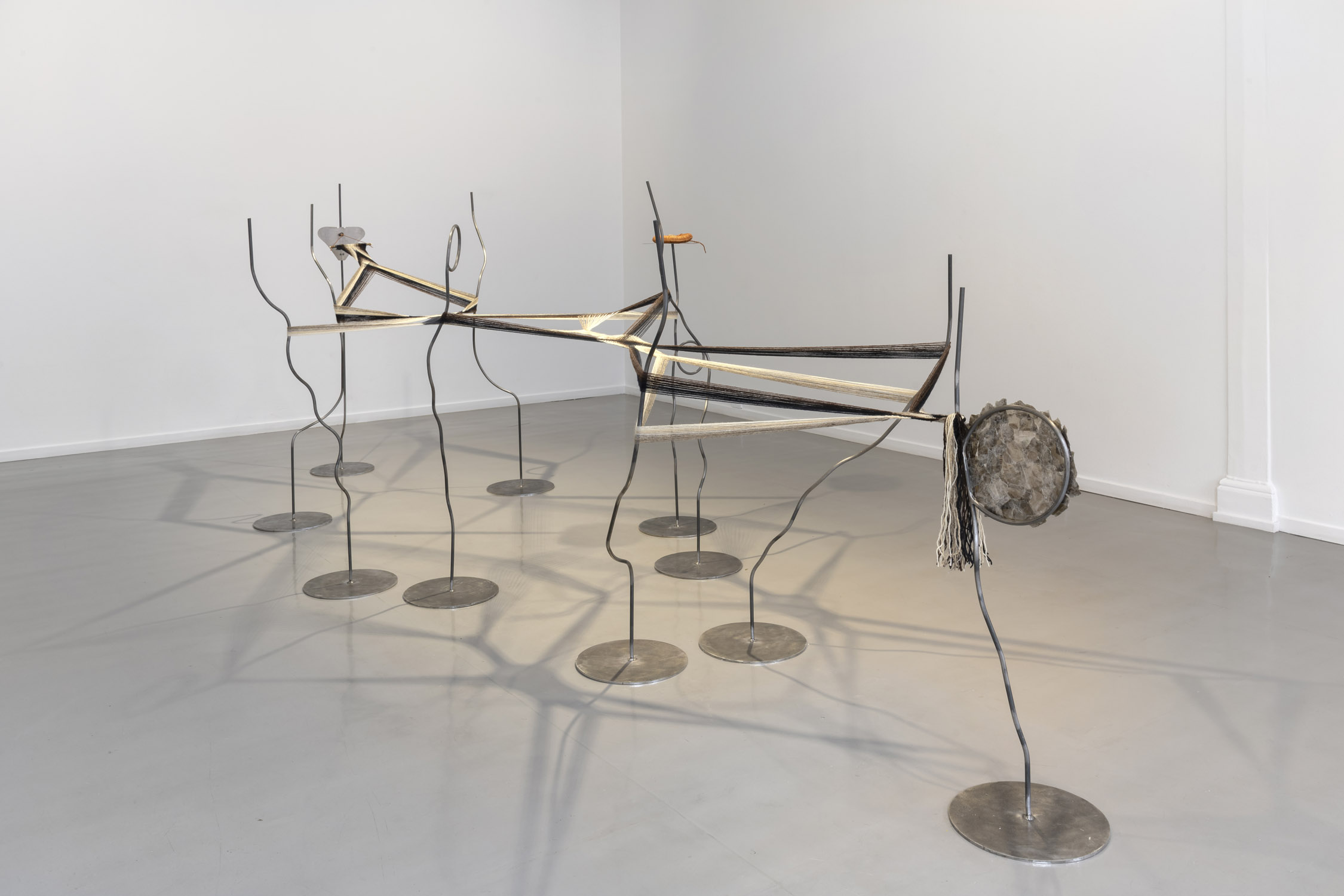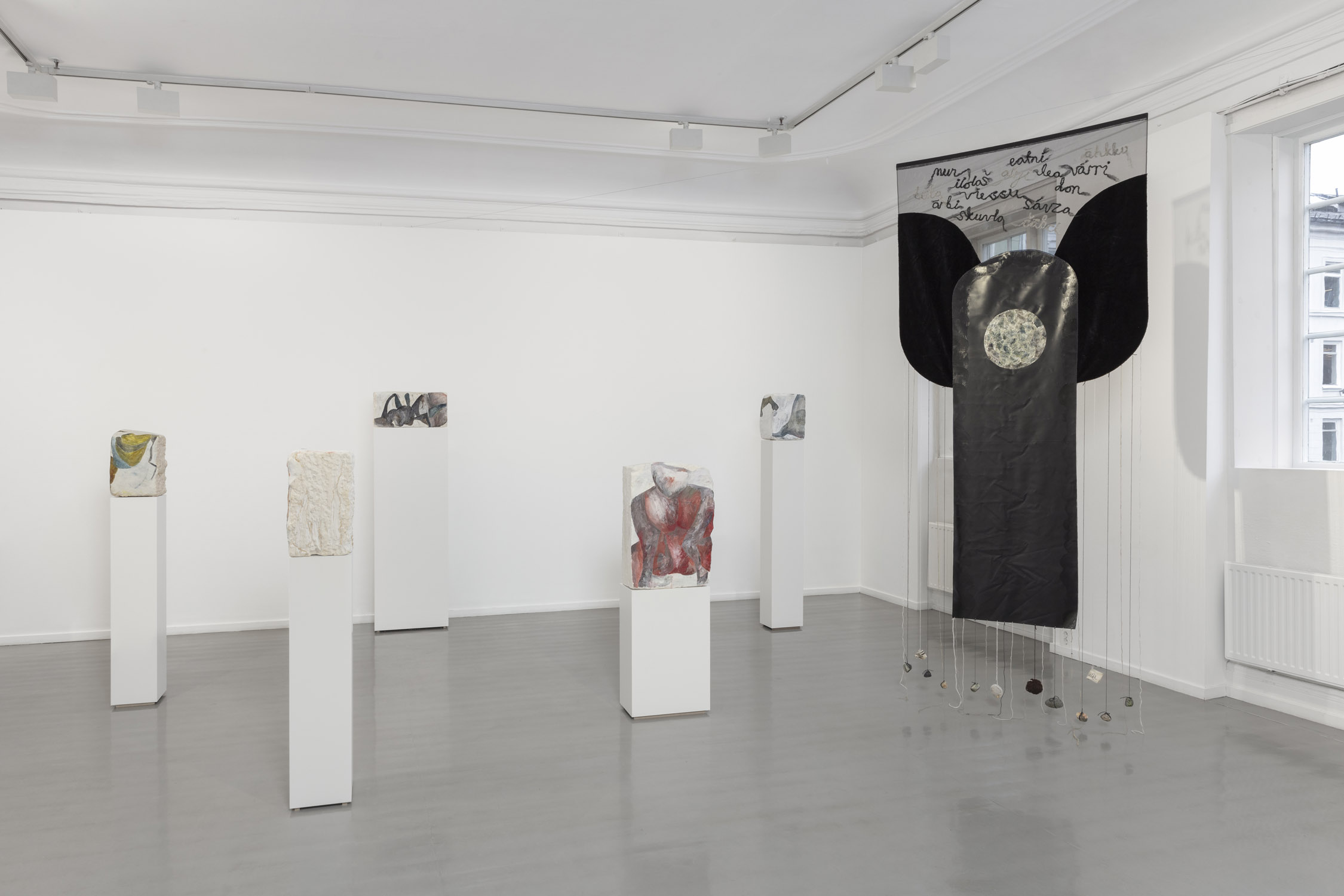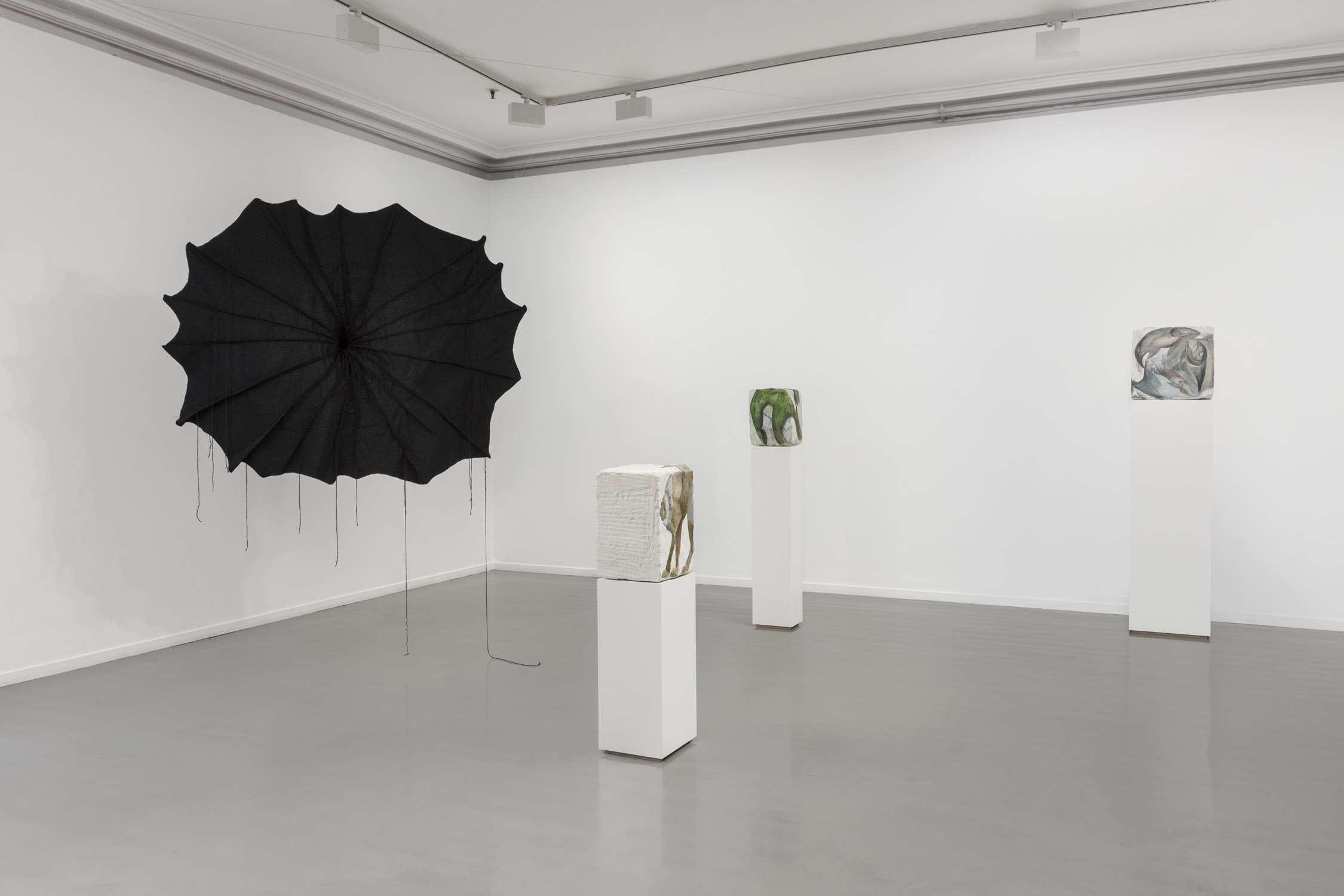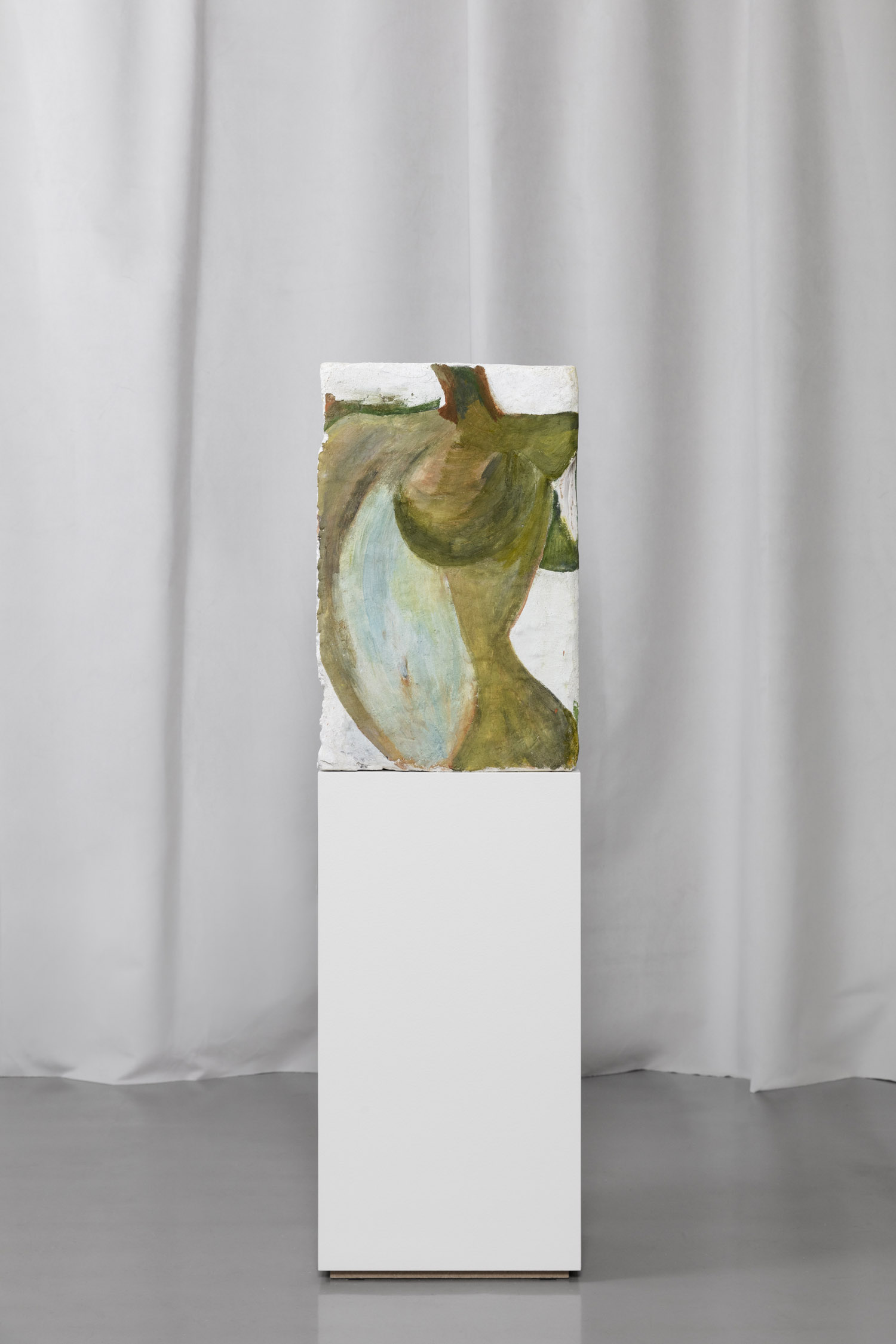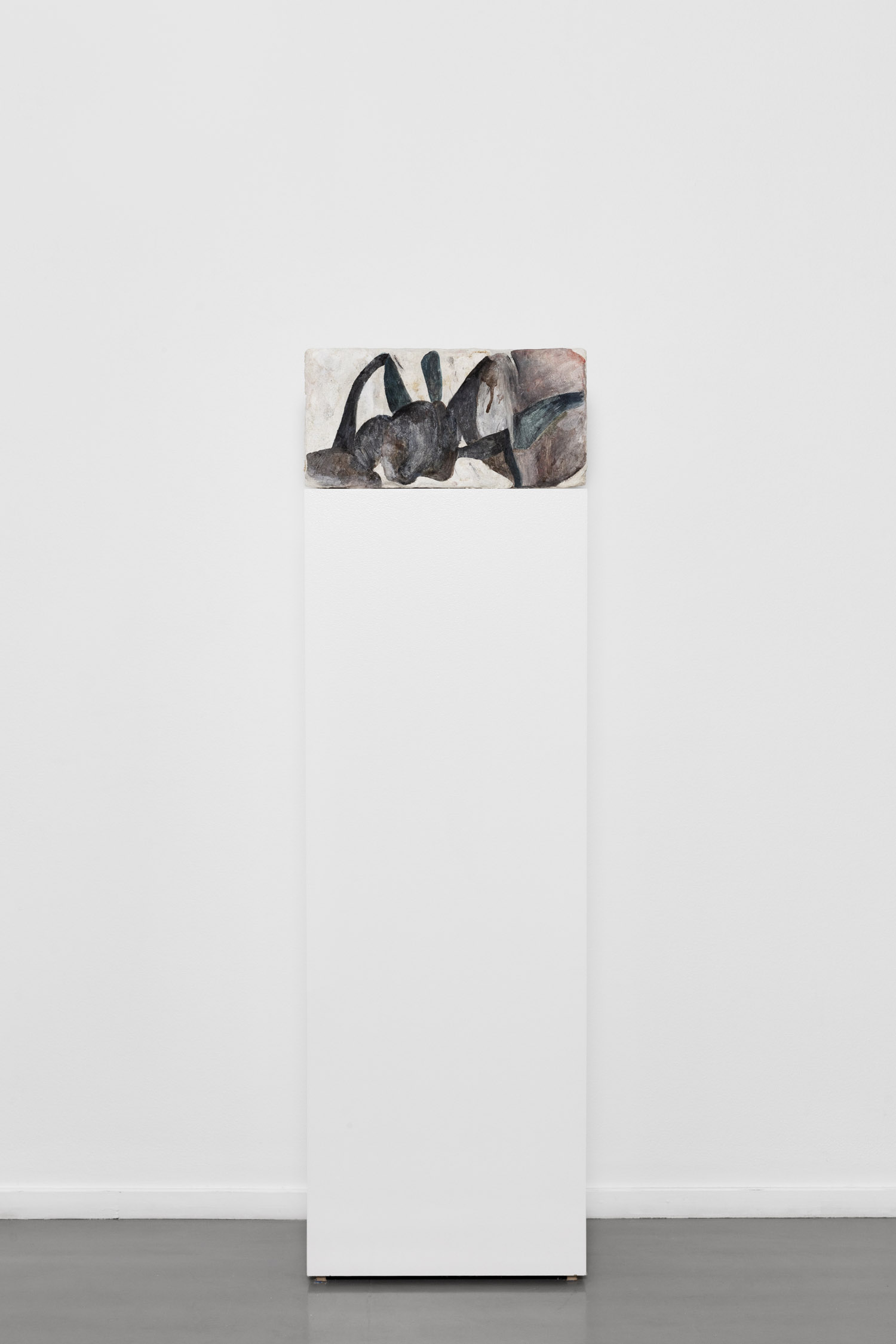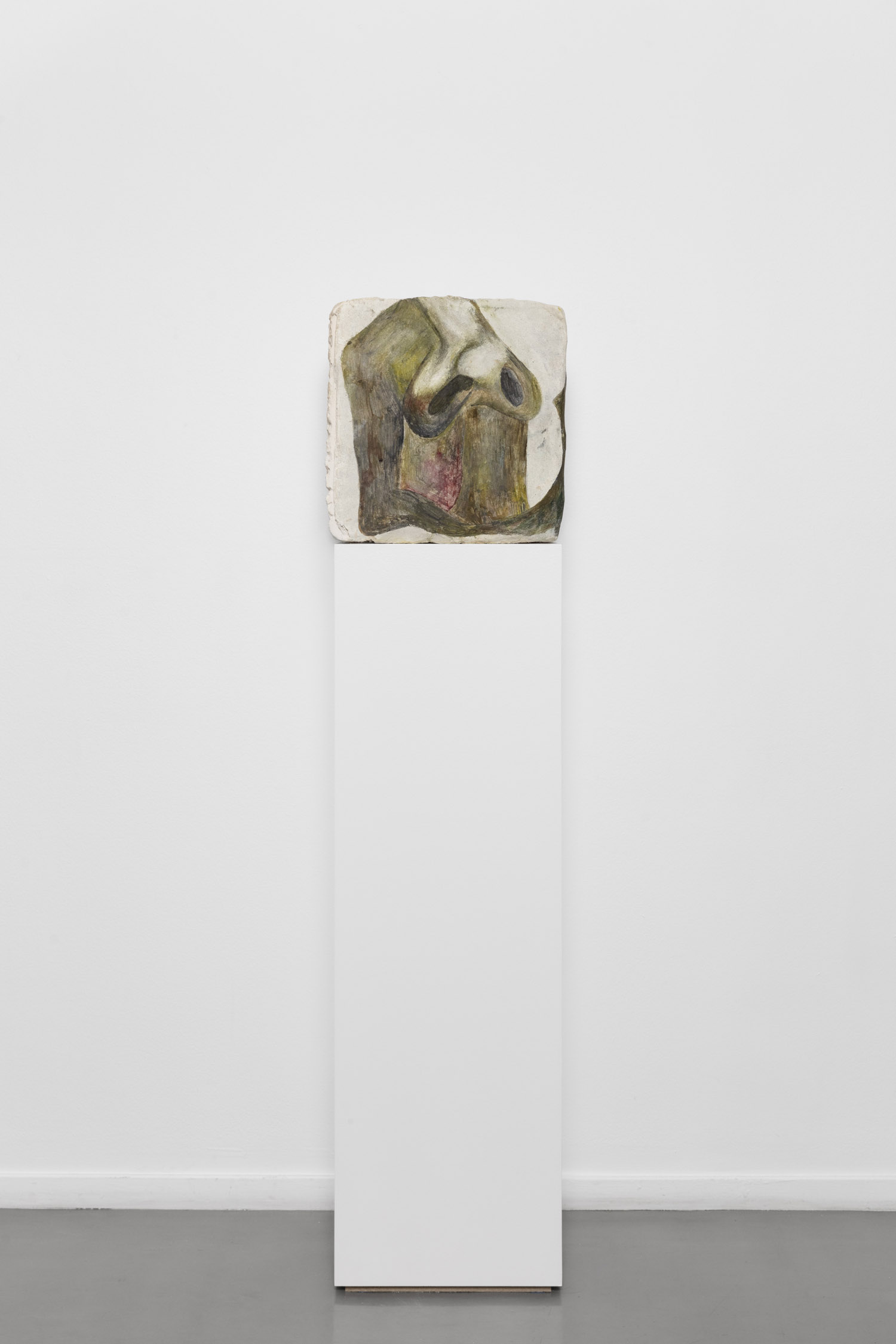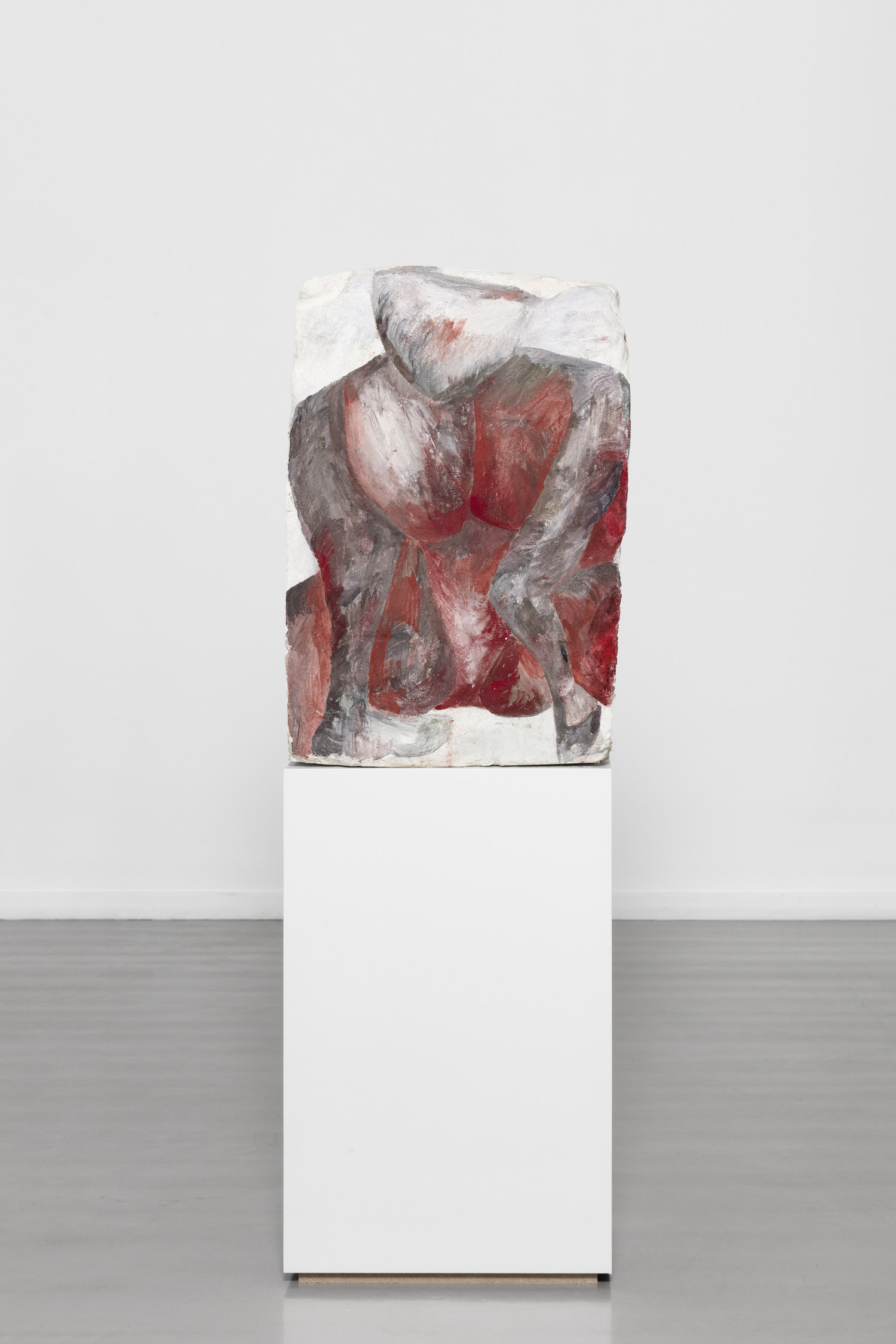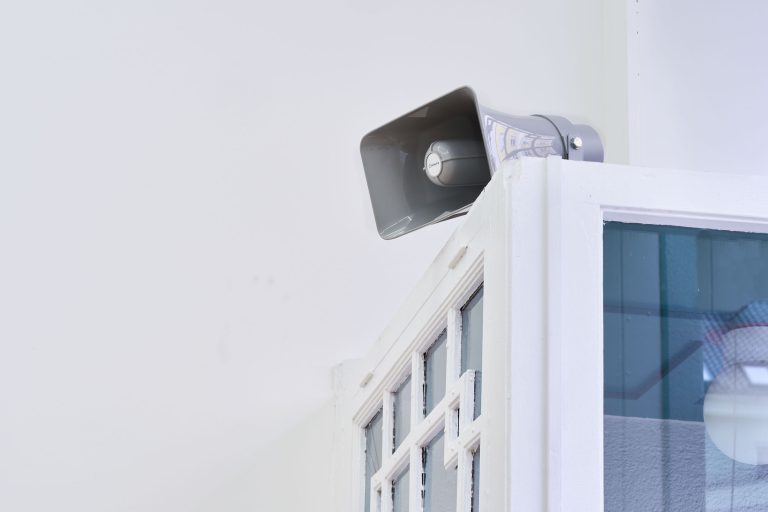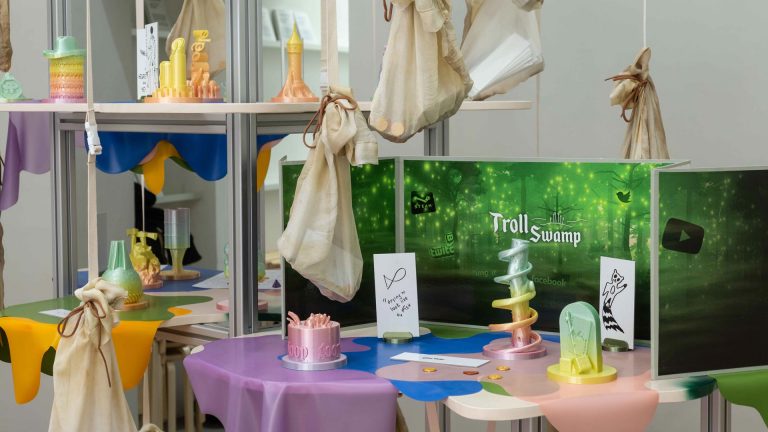where others had stepped there were traces in us presents the artists Melanie Kitti (b. 1986, SE) and Elina Waage Mikalsen (b. 1992, NO/SÁ). Both are interdisciplinary artists working across media. While Waage Mikalsen is both a musician and artist, Kitti’s work is a combination of her writing, painting and sculptural practices. In recent years, both artists have established themselves as significant voices in the contemporary art scene, each with a distinctive artistic language.
By inviting the two artists to inhabit the same exhibition space, curators Pauline Koffi Vandet (b. 1994, DK/CI) and Ida Højgaard Thjømøe (b. 1991, NO/DK), have created a dynamic that places the artists in dialogue with each other. This dialogue occurs conceptually, materially and spatially. Sometimes this dialogue reveals their artistic differences in counterpoint and sometimes the works resonate with each other, creating a harmonious polyphony.
Both artists process fragments of memory, both collective and personal. These fragments speak to wider notions of cultural heritage, cultural identity, marginalization, othering and belonging–notions that we inherit through impressions, traces, and scars inflicted on those who came before us. Both Kitti and Waage Mikalsen demonstrate how they are personally and collectively shaped by physical and abstract traces from previous generations – from both close familial relationships and also from powerful structural oppressions. These are traces from the past that create a complex web of imprints in the present.
The exhibition is part of Oslo Kunstforening’s initiative New Voices, where external, younger curators are invited to develop and curate an exhibition project specifically for the institution. The exhibition is supported by Art Council Norway and Danish Arts Foundation and The City of Oslo, in connection with the commemoration of the 400th anniversary of the city.
Exhibition text by Koffi & Højgaard
where others had stepped there were traces in us presents the artists Melanie Kitti (b. 1986, SE) and Elina Waage Mikalsen (b. 1992, NO/SÁ). Both are interdisciplinary artists working across media. While Waage Mikalsen is both a musician and artist, Kitti’s work is a combination of her writing, painting and sculptural practices. In recent years, both artists have established themselves as significant voices in the contemporary art scene, each with a distinctive artistic language.
By inviting the two artists to inhabit the same exhibition space, a dynamic is created that places the artists in dialogue with each other. This dialogue occurs conceptually, materially and spatially. Sometimes this dialogue reveals their artistic differences in counterpoint and sometimes the works resonate with each other, creating a harmonious polyphony.
Both artists process fragments of memory, both collective and personal. These fragments speak to wider notions of cultural heritage, cultural identity, marginalization, othering and belonging–notions that we inherit through impressions, traces, and scars inflicted on those who came before us. Both Kitti and Waage Mikalsen demonstrate how they are personally and collectively shaped by physical and abstract traces from previous generations–from both close familial relationships and also from powerful structural oppressions. These are traces from the past that create a complex web of imprints in the present.
Melanie Kitti
Melanie Kitti’s frescoes are both recognizable and alien. By appropriating a fresco technique, carried out on a wet surface, Kitti draws on an art and architectural tradition often associated with religious frescos dating back to the Middle Ages. The fresco technique is particularly known from Italy, with Michelangelo’s ceiling in the Sistine Chapel in the Vatican and Giotto’s frescoes in the Arena Chapel in Padua. Frescos are also found in many of the Scandinavian medieval churches, especially in Sweden and Denmark. The fresco technique is also used in Norway. Oslo City Hall, for example, houses several frescoes depicting important events and themes from Norwegian history and society. Kitti adapts this technique for the present, connecting it with contemporary storytelling and artistic expression.
Traditionally, frescos are site-specific pictorial imprints, known for their detailed and religious motifs, painted directly on the wall, and often only bounded by the architectural elements on which they have been painted. Kitti transforms this ancient medium into sculptural forms of dynamic organisms. By doing so, she introduces a fresh perspective challenging our notion of what a fresco is and can be.
Kitti’s frescoes are in various sizes, placed on pedestals of varying heights. The three-dimensional shape of the works take the painterly gestures into a spatial form that is associated with sculptures, busts or monuments. These are works that are in dialogue with the past, present, and future. From an art and cultural history perspective, the frescos evoke both prehistoric cave paintings and medieval religious murals. Just as our ancestors left historical frescos as testimonies of lived life, Kitti leaves traces of her own practice with people, animals, plants, and other living organisms that will be studied and discussed in the future.
Elina Waage Mikalsen
Sound, textile, performance, installation, and language intertwine in Elina Waage Mikalsen’s practice. She lets each story, investigation, and artistic project define how she uses different media. Waage Mikalsen’s works are deeply personal, often using fragments of her own family history, woven together with larger, collective stories from a Sámi perspective. With this, she explores and processes transmitted cultural traditions and transgenerational stories thereby conveying universal, timeless, and human emotions.
The Sámi, living across the borders of Norway, Sweden, Finland, and Russia, have been victims of the nation states’ brutal assimilation policies. In Norway, this policy lasted for more than a hundred years and was carried out through cultural and political measures. This stringent assimilation policy meant that many lost their language and culture, a tragic consequence that continues to impact the present. Whilst Waage Mikalsen does not, through her practice, focus solely on the pain connected to Sámi history – although impossible to entirely avoid – but rather she investigates how these policies have continued to leave traces – or imprints – leaving large gaps. There are both gaps we have left in history and gaps that history has left in us, characterized by shifts, tensions, and ambivalent feelings. With both a personal and a broader perspective, Waage Mikalsen attends to a culture of remembrance of rediscovered Sámi memories, ways of life, and worldviews.
In the exhibition, Waage Mikalsen presents a sound work, a mixed-media installation and several textile works, each of which references Sámi stories as well as collective and preservable Sámi craft traditions. She appropriates, weaves, and perforates the works’ materials, be they wool, glimmer, plastic, or wood. In many ways, the various works are situated somewhere between the physical and spiritual worlds and are in a continuous dialogue between the past and present, the personal and the collective.
Biographies
Melanie Kitti (b. 1986, SE) is an artist and writer educated at the Royal Danish Academy of Fine Arts in Copenhagen, the Oslo National Academy of the Arts, and at the Writers’ School in Copenhagen. Her critically acclaimed debut book Halvt urne, halvt gral was published by Gyldendal in 2022. Kitti was one of the founders of Abhivyakti, a non-profit magazine with only BIPOC contributors, and has helped organize the exhibition space Destiny’s in Oslo (2016–22). Kitti’s works have been shown in solo and group exhibitions at places such as Overgaden in Copenhagen (2023), Rønnebæksholm in Næstved (2022–23), the National Museum in Oslo (2022), and Carl Eldh’s studio museum in Stockholm (2024).
Elina Waage Mikalsen (b. 1992, NO/SÁ) is an artist and musician from Romssa/Tromsø. She works with a wide range of media, primarily focusing on sound and listening. Waage Mikalsen was educated at the Nordland Art and Film School, Academy of Arts in Tromsø and the Oslo National Academy of the Arts. From 2022-24 she was a guest artist and co-curator at Borealis – a festival for experimental music. She runs Šuvva, a platform for Sámi sound art, experimental music, and listening. Waage Mikalsen has exhibited and performed nationally and internationally at venues such as the National Museum in Oslo, the Singapore Biennale, the Lofoten International Art Festival, Kunsthal Charlottenborg in Copenhagen, and Kunstnernes Hus in Oslo.
The curatorial duo Koffi & Højgaard was founded in 2023 and consists of Pauline Koffi Vandet (b. 1994, DK/CI) and Ida Højgaard Thjømøe (b. 1991, DK/NO). Their goal is to use the exhibition space as a platform for difficult, conflict-filled, and vulnerable conversations. In addition to their joint curatorial practice, Koffi Vandet works as the temporary director at Fotografisk Center, and Højgaard Thjømøe works as an art consultant for the Danish Arts Foundation and runs HAC – a consultancy for art in public spaces. In 2024, they will curate exhibitions at Nikolaj Kunsthal and Oslo Kunstforening.continuous dialogue between the past and present, the personal and the collective.

